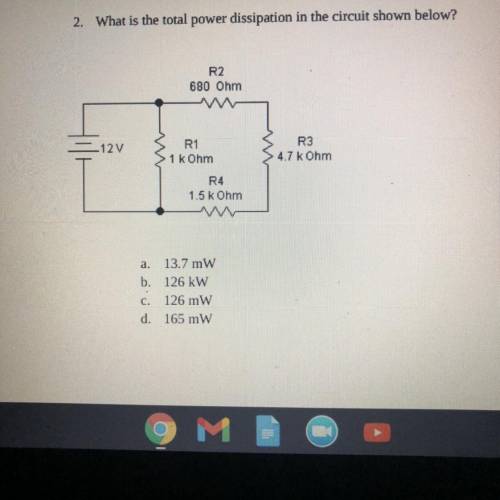2. What is the total power dissipation in the circuit shown below?
R2
680 Ohm
M
-...

Computers and Technology, 09.11.2020 17:20 erenackermanlevijaeg
2. What is the total power dissipation in the circuit shown below?
R2
680 Ohm
M
-12v
R1
1 k Ohm
R3
4.7 kOhm
R4
1.5 k Ohm
a. 13.7 mW
b. 126 kW
c. 126 mW
d. 165 mW


Answers: 3
Another question on Computers and Technology

Computers and Technology, 22.06.2019 01:30
What “old fashioned” features of checking accounts is p2p replacing
Answers: 3

Computers and Technology, 22.06.2019 12:00
The following function returns a string of length n whose characters are all 'x'. give the order of growth (as a function of n) of the running time. recall that concatenating two strings in java takes time proportional to the sum of their lengths. public static string f(int n) { if (n == 0) return ""; if (n == 1) return "x"; return f(n/2) + f(n - n/2); } options: a) constant b) logarithmic c) linear d) linearithmic e)quadratic f)cubic g) exponential
Answers: 2

Computers and Technology, 22.06.2019 18:00
Determine whether the following careers would require training or college.
Answers: 1

Computers and Technology, 23.06.2019 17:30
When making changes to optimize part of a processor, it is often the case that speeding up one type of instruction comes at the cost of slowing down something else. for example, if we put in a complicated fast floating-point unit, that takes space, and something might have to be moved farther away from the middle to accommodate it, adding an extra cycle in delay to reach that unit. the basic amdahl's law equation does not take into account this trade-off. a. if the new fast floating-point unit speeds up floating-point operations by, on average, 2ă—, and floating-point operations take 20% of the original program's execution time, what is the overall speedup (ignoring the penalty to any other instructions)? b. now assume that speeding up the floating-point unit slowed down data cache accesses, resulting in a 1.5ă— slowdown (or 2/3 speedup). data cache accesses consume 10% of the execution time. what is the overall speedup now? c. after implementing the new floating-point operations, what percentage of execution time is spent on floating-point operations? what percentage is spent on data cache accesses?
Answers: 2
You know the right answer?
Questions

Spanish, 04.07.2019 00:00

Spanish, 04.07.2019 00:00











Mathematics, 04.07.2019 00:00




History, 04.07.2019 00:00





